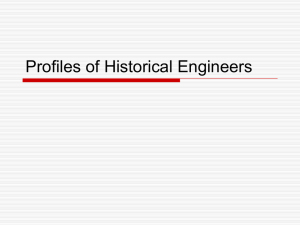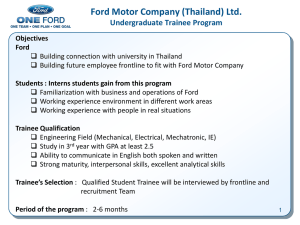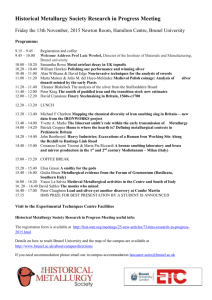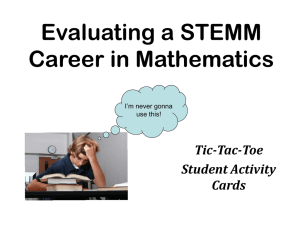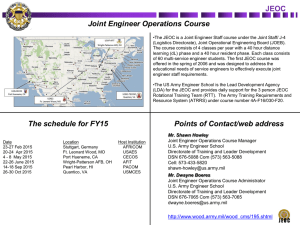Powerpoint for Profiles in Engineering
advertisement
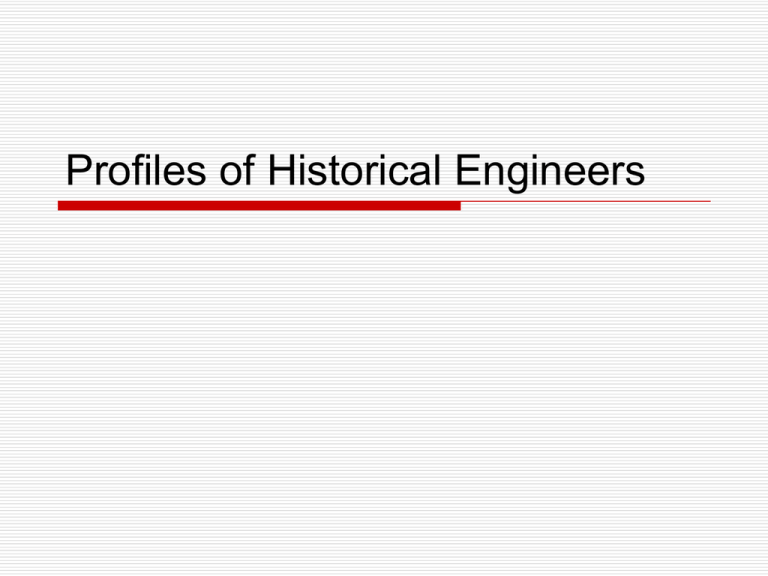
Profiles of Historical Engineers Nolan K. Bushnell (1943- http://www.atarimagazines.com/v3n12/profiles.html ) Father of the Video Game Industry Founded Atari in 1972 Launched video game revolution with Pong Sold Atari in 1976 $28 million http://homepages.compuserve.de/rspezial/vidgas/atarilog.htm Found Chuck E. Cheese’s restaurant Sold after few years http://www.globalicons.com/clients/chucke/ main-intro-l.html Started over 20 companies since Atari Credentials Received a B.S. in Electrical Engineering from the University of Utah Attended Graduate school at Stanford Lectures at major universities and corporations inspired others University of Utah www.utah.edu Thomas Alva Edison (1847-1931) http://www.cojeco.cz/index.php?detail=1&s_lang=2&id_desc=23024 Man of Dreams and Determination “If we did all the things we were capable of doing, we would literally astound ourselves.” Laid groundwork for technological advances used today http://www.shakerwssg.org/b__w_antique_clip_art.htm An Inventor’s Adventure Edison in front of his Universal Stock Printer 1862 at age 15, Edison left home to work as a telegrapher in Canada and U.S. In 1869 he invented the Universal Stock Printer Automatically printed stock telegraphs Received $40,000 in compensation http://dspt.club.fr/EDISONbio.htm Professional Inventor/Engineer Created the cylinder phonograph and sold to Edison Speaking Phonograph Company Received $10,000 + 20% of company profits Income helped him focus on incandescent light bulb, most famous accomplishment http://www.exploravision.org/calendar/february/feb11a.htm Greatest Engineer 1,093 patents 10 companies started General Electric was one of the companies developed “Genius is 1% inspiration and 99% perspiration.” Leonardo da Vinci (1452-1519) http://digilander.libero.it/mickymaus/index.htm Weaponry envisionist Da Vinci Drawing on the His Mechanism for Flying http://home.att.net/~o.caimi/Leonardo.html Helicopters, tanks, artillery and other weaponry envisioned Handicap was inability to read Latin Did not bother him, wanted to use his engineering skills to improve his environment Leonardo’s Resume Engineered hundreds of useful and useless devices Hired as Painter and Engineer to the Duke Produced spectacular shows for aristocracy that came to the Duke’s court. Detailed over 5,000 pages of notes of conceivable inventions Claims da Vinci made Construct movable bridges Remove water from moats Destroy anything not made of stone Make mortars Make flame throwers Design ships and weapons for sea Dig tunnels without making noise Sculpt and Paint Isambard Kingdom Brunel (1806-1859) http://www.cwhistory.com/history/TeacherPack/brunel.html Most Diverse and Capable Engineer in History Designed variety of projects Railways to bridges and ships Sent to college at the age of 14 Went to work as an apprentice at 16 in father’s engineering office Advanced to resident engineer of Thames Tunnel at age 20 Competition Brunel entered suspension bridge project over Avon Gorge Top competitor, Thomas Telford, was also a judge on the competition panel All Brunel’s designs rejected, Telford’s accepted One design accepted in second contest Designs and Advancements Lead designer for Great Western Railway Designed everything for the project Used fundamental logic and analysis to reshape mechanical and structural engineering of his time Reshaped art and technology of architecture Brunel died at 53 without completion of Clifton Suspension Bridge Charles Proteus Steinmetz (1865-1923) http://www.oya-es.net/reportajes/proteus.htm Pioneer in Electrical Engineering “No man really becomes a fool until he stops asking questions.” Research lead him to the development of theories for alternating current Theories helped with inventions using electrical power Valuable Engineer Generator malfunctions and no technician knew how to fix Retired Charles is called in to diagnose and fix the broken generator Marked malfunctioned part with a Chalk “X” Billed company $1000, who asked for itemized billing statement “Marking chalk X on side of generator: $1. Knowing where to mark chalk X: $999.” 200 Electrical Patents Electromagnetism work is greatest accomplishment Devices to protect power lines from lighting strikes Designs for electric vehicles Production work stopped at his death Henry Ford (1863-1947) http://www.americaslibrary.gov/jb/civil/jb_civil_ford_1_e.html Man on a Mission Disliked school and farm life in hometown of Dearborn, MI Moved to Detroit and became an apprentice in small engines shop Moved home and opened own shop several years later Designed first vehicle at Detroit Edison Company after working his way to Chief Engineer Henry Ford’s Quadricycle Buggy frame 4 bicycle tires as wheels Lead to the opening of the Ford Motor Company in 1903 http://www.bluemoongear.com/ArcCarsFord.htm Advancement’s in Society Model T, “everyman’s car,” introduced in 1908 and stayed on market for 19 years Advancements in production technology allowed for better marketing of vehicle 1913, assembly line created and made production cheaper and more cars Ford instituted minimum wage of $5.00/day and the 5-day workweek Developed a franchise system to sell and service cars, well before McDonald’s opened Dr. Robert Goddard (1882-1945) http://www.sil.si.edu/Exhibitions/Voyages/explaining-the-heavens.htm Modern Rocket Inventor His design to lift a rocket off the ground not using solid fuels Bi-fuel system Fuel and oxidizer mixed right before ignition Designs similar to his used in space vehicles, deliver warheads and satellites used in communication and espionage http://www.eworcester.com/extra/goddard/photos.html Unrecognized Contributions Contributed to theories and realization of rockets Dr. Goddard at Clark University in Worcester, Massachusetts, in 1924 Labors went unrecognized until dawn of “Space Age” http://history.msfc.nasa.gov/goddard/gallery/gpn-2002-000130.html Wilbur (1867-1912) and Orville (1871-1948) Wright www.uncp.edu/gpac/youth/ Young Aeronautical Engineers Curious with the work of Otto Lilienthal German scientist who tested kites and gliders Both determined to design first flying model Orville built first wind tunnel to test wing designs http://www.first-to-fly.com/Adventure/Workshop/lift_and_drift.htm Accomplishments aviationhistory.info/ Wright-photos.html Credited for piloting first successful flight Manner in which they went about testing should be considered greatest accomplishment Flight would have never occurred without these practices Grace Murray Hopper (1906-1992) http://www.dma.eui.upm.es/historia_informatica/Doc/Personajes/GraceHooper.htm Those Computer Bugs Computer engineer and Rear Admiral in the U.S. Navy Developed first computer compiler in 1952 Moth had jammed the works of an early computer Term “Bug” coined Honors and Awards 1969 - Data Processing Management Association’s first Computer Science Manof-the-Year Award 1973 - First woman and U.S. citizen to be made a Distinguished Fellow of the British Computer Society Multiple honorary doctorates from universities across nation 1991 - National Medal of Technology Joseph B. Strauss (1827-1870) http://www.sfmuseum.org/hist9/mcgloin.html The Golden Gate Bridge http://www.sfmuseum.net/assoc/bridge07.html Many engieers said costs could reach $100 million Strauss’ (experience with 400 spans) design estimated $27 million Strauss dedicated to financing, as the government had no funds for the project Specifications Provisional permit granted in 1924, opposition to project halted construction to start in 1933 Bridge spans 1,280 m Connects San Francisco and Marin County Weighs 887,000 tons Long cables suspended through the air Enough to circle world 3 times http://www.mikelevin.com/BayArea.htm Leo Szilard (1898-1964) http://www.exn.ca/Stories/1997/03/20/02.asp Nuclear Engineer Studied engineering in Budapest and Berlin Left Germany for London to escape Nazi persecution 1933 - patented nuclear chain reaction 1937 - moved to New York City The Manhattan Project http://ffden-2.phys.uaf.edu Worries of Germans developing first atomic bomb Rushed U.S. to build first atomic bomb December 2, 1942 the first controlled nuclear chain reaction developed Advocated against use as a weapon
